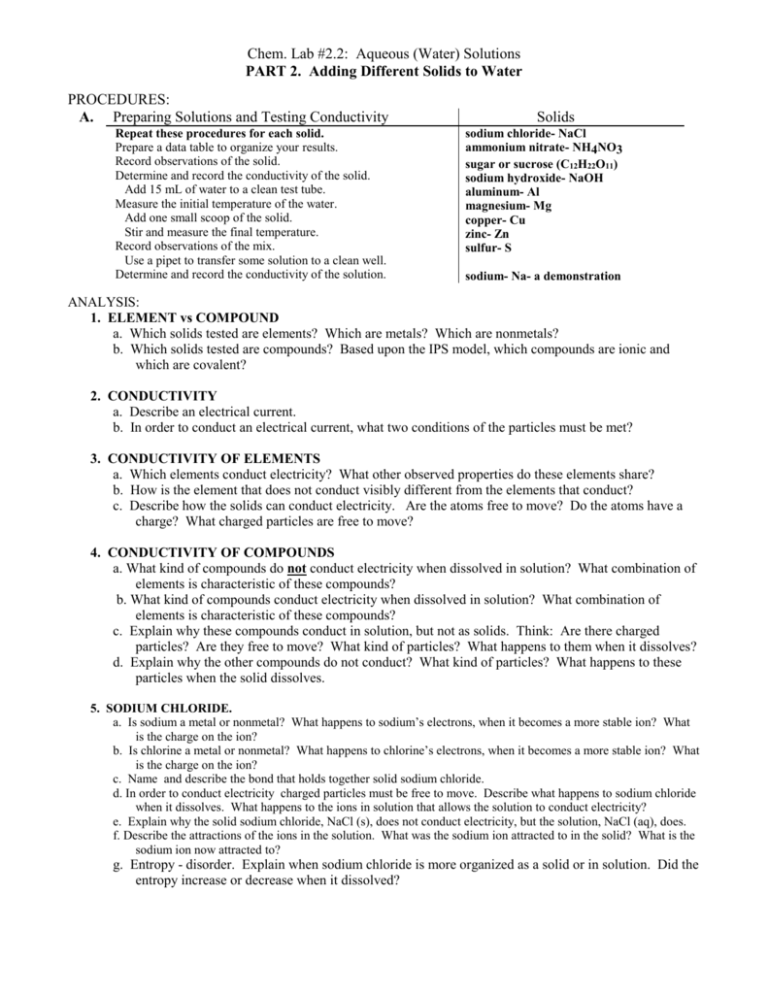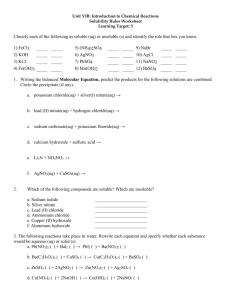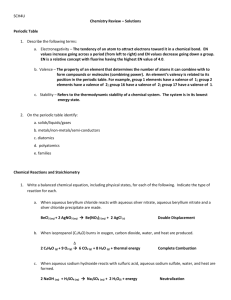Lab: Aqueous (Water) Solutions
advertisement

Chem. Lab #2.2: Aqueous (Water) Solutions PART 2. Adding Different Solids to Water PROCEDURES: A. Preparing Solutions and Testing Conductivity Repeat these procedures for each solid. Prepare a data table to organize your results. Record observations of the solid. Determine and record the conductivity of the solid. Add 15 mL of water to a clean test tube. Measure the initial temperature of the water. Add one small scoop of the solid. Stir and measure the final temperature. Record observations of the mix. Use a pipet to transfer some solution to a clean well. Determine and record the conductivity of the solution. Solids sodium chloride- NaCl ammonium nitrate- NH4NO3 sugar or sucrose (C12H22O11) sodium hydroxide- NaOH aluminum- Al magnesium- Mg copper- Cu zinc- Zn sulfur- S sodium- Na- a demonstration ANALYSIS: 1. ELEMENT vs COMPOUND a. Which solids tested are elements? Which are metals? Which are nonmetals? b. Which solids tested are compounds? Based upon the IPS model, which compounds are ionic and which are covalent? 2. CONDUCTIVITY a. Describe an electrical current. b. In order to conduct an electrical current, what two conditions of the particles must be met? 3. CONDUCTIVITY OF ELEMENTS a. Which elements conduct electricity? What other observed properties do these elements share? b. How is the element that does not conduct visibly different from the elements that conduct? c. Describe how the solids can conduct electricity. Are the atoms free to move? Do the atoms have a charge? What charged particles are free to move? 4. CONDUCTIVITY OF COMPOUNDS a. What kind of compounds do not conduct electricity when dissolved in solution? What combination of elements is characteristic of these compounds? b. What kind of compounds conduct electricity when dissolved in solution? What combination of elements is characteristic of these compounds? c. Explain why these compounds conduct in solution, but not as solids. Think: Are there charged particles? Are they free to move? What kind of particles? What happens to them when it dissolves? d. Explain why the other compounds do not conduct? What kind of particles? What happens to these particles when the solid dissolves. 5. SODIUM CHLORIDE. a. Is sodium a metal or nonmetal? What happens to sodium’s electrons, when it becomes a more stable ion? What is the charge on the ion? b. Is chlorine a metal or nonmetal? What happens to chlorine’s electrons, when it becomes a more stable ion? What is the charge on the ion? c. Name and describe the bond that holds together solid sodium chloride. d. In order to conduct electricity charged particles must be free to move. Describe what happens to sodium chloride when it dissolves. What happens to the ions in solution that allows the solution to conduct electricity? e. Explain why the solid sodium chloride, NaCl (s), does not conduct electricity, but the solution, NaCl (aq), does. f. Describe the attractions of the ions in the solution. What was the sodium ion attracted to in the solid? What is the sodium ion now attracted to? g. Entropy - disorder. Explain when sodium chloride is more organized as a solid or in solution. Did the entropy increase or decrease when it dissolved? 6. SODIUM HYDROXIDE An ionic bond holds together sodium ions and hydroxide ions in solid sodium hydroxide. a. Describe the attractions between the ions in the solid. Name this bond. What must happen to this attraction when the sodium hydroxide is added to water. Draw a diagram of the solid sodium hydroxide. b. What new attractions are formed in solution? Describe and draw the solution of sodium hydroxide. c. Describe the reaction in terms of energy added to break bonds and energy released when bonds form. Was this reaction endothermic or exothermic? Support with your observations. Make an inference about the energy to break compared to the energy released in formation. d. Construct an energy graph to show the relative energy levels of solid sodium hydroxide and aqueous sodium hydroxide. Is this reaction favored to occur based upon the change in enthalpy? Explain. e. Is this reaction favored based upon the change in entropy? Explain your reasoning. f. Sodium hydroxide is a base. What ion is present in basic solutions? + - 7. AMMONIUM NITRATE An ionic bond holds ammonium ions- NH4 and nitrate ions- NO3 together in solid ammonium nitrate. a. Ammonium and nitrate are both polyatomic ions. Define a polyatomic ion. b. Describe what must happen to the ions and the bonds when the ammonium nitrate is added to water. What new bonds are formed? c. Describe the reaction in terms of energy to break the original bonds and energy released in the formation of new bonds. Was this reaction endothermic or exothermic? Support with your observations. Make an inference about the energy added to break compared to the energy released in formation. d. Construct an energy graph to show the relative energy levels of solid ammonium nitrate and aqueous ammonium nitrate. Is the reaction favored based upon enthalpy? e. Is this reaction favored based upon entropy? Explain your reasoning. f. This reaction did occur at room temperature. Which factor favored the reaction? Which factor did not favor the reaction? Which favor must have made a bigger difference? 8. METALS. Metals conduct electricity. Metals have a loose-hold on their electrons. The electrons are shared by all the atoms as a loose sea of electrons- a metallic bond. a. Describe a metallic bond. What charged particles are free to move in the solid metal? How does this relate to conductivity? b. The solid metals are composed of atoms. Locate the five metals on the periodic table. For each metal- answer the following questions in an organized table. • What is the atomic number? • How many protons and electrons in the neutral atom? • What column is it located in? What row? • What is the atomic mass? • What is the mass of one mole? How many atoms in the one mole? c. Which metals reacted in water? What is your evidence? Which metal must be the least stable? Explain your reasoning. d. Which metals did not react in water? What is your evidence? Are these metals stable or unstable? Explain your reasoning. e. Propose an explanation for the difference in the behavior of the metals. 9. COLLISION MODEL. Use the collision model to explain how increasing the temperature of the water would increase the rate of reaction when magnesium is added to water. Remember: In order to react the particles must hit with enough force to break bonds. 10. CONCENTRATION CALCULATIONS a. Find the mass per mole of the following compounds: sodium chloride, sodium hydroxide, ammonium nitrate b. Find the concentration of the solution in moles/ liter If 0.5 grams of each solid was added to 15 mL of water. If 5 grams of each solid were dissolved in 50 mL of water.






